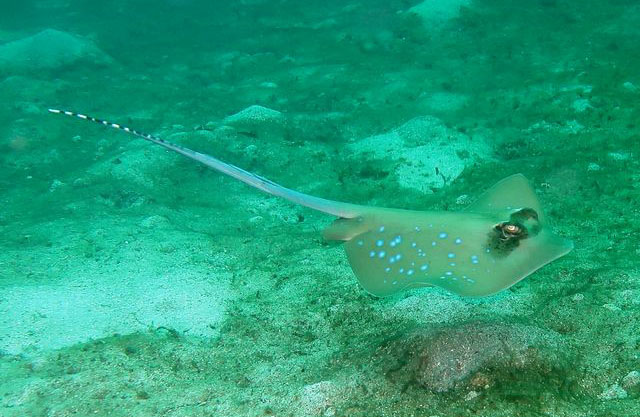| Dasyatidae (Stingrays), subfamily: Neotrygoninae |
| 38 cm WD (male/unsexed) |
|
reef-associated; marine |
| Western Central Pacific: Indonesia, Malaysia (Borneo), the Philippines and Taiwan. |
|
This small Neotrygon species of the kuhlii-complex (reaching at least 38 cm DW; males maturing at 22 cm DW) is distinguished by the following set of characters: disc is much broader than long, width 1.2-1.3 times length; pectoral apices are abruptly angular; snout fleshy, broadly rounded to weakly angular, with an angle 124-129°, length 1.9-2.5 times interorbital width; the maximum width relatively well forward on disc, length from snout tip to pectoral-fin insertion 1.8-2 times and disc width 2.7-2.9 times horizontal distance from snout tip to maximum disc width; preoral length 1.8-.2 times the mouth width; internasal distance is 1.3-1.6 in prenasal length; interspiracular distance 13-16% DW; nostril length 3.1-3.8% DW; nasal curtain width 8.9-10% DW; mouth small, its width 7-7.5% DW; the horizontal distance from cloaca to caudal sting base is 48-56% of disc length; presence of thornlets in nuchal region and weakly developed in the lumbar regions in adults, none from tail in all sizes; minute, widely-spaced dermal denticles present on mid-disc of large adults; pectoral-fin radials 105-110; total vertebral centra (including synarcual) 125-141, trunk centra (including synarcual) 36-42; with moderately large blue spots on disc, largest 0.5-0.9 in eye width, few on medial belt, 0-6 (mean 0.4), largest 2.8-3.3% DW; mask-like marking is rather pronounced, covered with dark peppery spots; the ventral surface of disc with diffuse greyish submarginal bands; ventral tail fold is dusky with darker edge (Ref. 116741). |
| This species found demersal, inshore to mid-continental and on insular shelves. Accurate depth range is not available but probably found usually inshore at depths less than 100 meters. Reported pregnant females contained only a single pup with size at birth of ca.12.0 cm (Ref. 114953). |
|
Least Concern (LC); Date assessed: 20 May 2020 Ref. (130435)
|
| harmless |
Source and more info: www.fishbase.org. For personal, classroom, and other internal use only. Not for publication.

